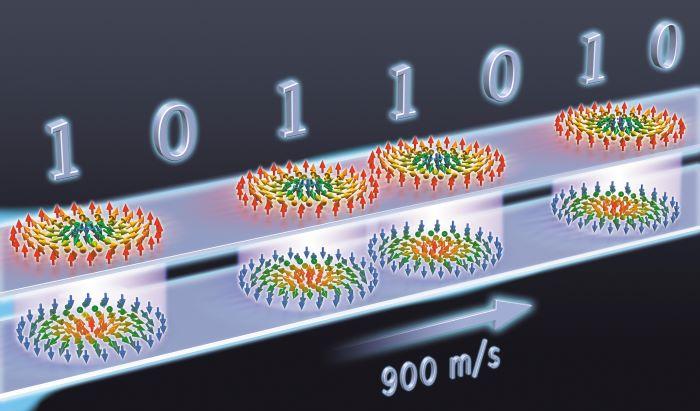An international research team led by scientists from the CNRS1 has discovered that the magnetic nanobubbles2 known as skyrmions can be moved by electrical currents, attaining record speeds up to 900 m/s.

Credit: © Bruno Bourgeois and Olivier Boulle
An international research team led by scientists from the CNRS1 has discovered that the magnetic nanobubbles2 known as skyrmions can be moved by electrical currents, attaining record speeds up to 900 m/s.
Anticipated as future bits in computer memory, these nanobubbles offer enhanced avenues for information processing in electronic devices. Their tiny size3 provides great computing and information storage capacity, as well as low energy consumption.
Until now, these nanobubbles moved no faster than 100 m/s, which is too slow for computing applications. However, thanks to the use of an antiferromagnetic material4 as medium, the scientists successfully had the skyrmions move 10 times faster than previously observed.
These results, which were published in Science on 19 March, offer new prospects for developing higher-performance and less energy-intensive computing devices.
This study is part of the SPIN national research programme5 launched on 29 January, which supports innovative research in spintronics, with a view to helping develop a more agile and enduring digital world.
notes :
1 – The French laboratories involved are SPINTEC (CEA/CNRS/Université Grenoble Alpes), the Institut Néel (CNRS), and the Charles Coulomb Laboratory (CNRS/Université de Montpellier).
2 – A skyrmion consists of elementary nanomagnets (“spins”) that wind to form a highly stable spiral structure, like a tight knot.
3 – The size of a skyrmion can reach a few nanometres, which is to say approximately a dozen atoms.
4 – Antiferromagnetic stacks consist of two nano-sized ferromagnetic layers (such as cobalt) separated by a think non-magnetic layer, with opposite magnetisation.
5 – The SPIN priority research programme and equipment (PEPR) is an exploratory programme in connection with the France 2030 investment plan.
Journal
Science
Article Title
Fast current induced skyrmion motion in synthetic antiferromagnets without skyrmion Hall effect
Article Publication Date
19-Apr-2024




